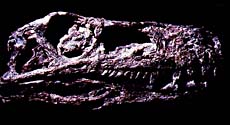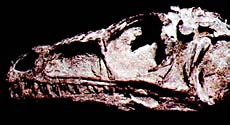 |
 |

The Late Triassic (Carnian) deposits of the Ischigualasto Formation contain some of the oldest known dinosaur remains. Of those sites containing the earliest dinosaurs, Ischigualasto ranks second in fame, after the Chinle Formation of North America, but ranks first in the quality, number, and importance of its dinosaur finds. It is also the only place in the world where nearly all of the Triassic is represented in an undisturbed sequence of rock deposits, and both the overlying and underlying formations have also yielded important fossils of early dinosaurs as well as of early synapsids and freshwater fish.
The true importance and fossil-richness of this region was not appreciated until the first joint Argentine-US paleontological expeditions to Ischigualasto were made in the 1950s, though geologic surveys had begun some sixty years earlier. The Harvard paleontologist A. S. Romer was so taken with the locality, that he wrote the following in his diary:
It is the delight of all vertebrate paleontologists, to get up in the morning, leave the tent and find themselves surrounded by the most extraordinary fossil cemetery ever imagined. And all perfectly preserved. --A. S. Romer, 1958
Located in northwestern Argentina, near the border with Chile, Ischigualsto is a basin region of sandstone and mudstones. These arid badlands have a bizarre and rugged terrain that has given it the popular name "Valley of the Moon". In the Carnian, 230 million years ago, this area was a volcanically active floodplain dominated by rivers and had a strongly seasonal rainfall. Huge petrified tree trunks of Protojuniperoxylon ischigualastianus more than 40 meters tall attest to a rich vegetation at that time. The proper affinities of these trees is not known, but their wood resembles that of the Araucariaceae. Fossil ferns, such as Cladophlebis, and horsetails have also been found. Unfortunately, we know comparatively little about the Triassic vegetation from this formation; the underlying layers provide much better sources for plant fossils.
 |
 |
Ischigualasto Dinosaurs : Two of the most exciting dinosaur finds at Ischigualasto are shown above. On the left, the skull of Herrerasaurus. Originally known from fragmentary remains, a complete and intact skull was found on an expedition in 1988. On the right, Eoraptor lunensis, one of the most "primitive" dinosaurs yet discovered.
Perhaps surprisingly, dinosaurs are neither the most numerous, nor the largest animals from Ischigualasto. Only about 6% of all tetrapods found there are dinosaurs. Rhyncosaurs and cynodonts are far more common, and in fact the rhyncosaur Scaphonix accounts for half of all tetrapod fossils. This suggests that dinosaurs were not an immediate success when they first appeared, especially considering that Ischigualasto is relatively rich in dinosaur remains for such an early date. Despite the rarity of these early dinosaur fossils, their importance for understanding early dinosaur evolution is tremendous. Fossils from this site include both early ornithischians, such as Pisanosaurus, and putative early saurischians, the two major lineages of dinosaurs. These fossils therefore establish not only that dinosaurs existed by this time, but that they had begun to diversify.
The carnivorous archosaur Herrerasaurus is the most numerous of these dinosaur fossils, though there is some controversy over its true nature. While it has many of the features found in dinosaurs, it lacks certain features of the hip and leg bones, and so may be a close dinosaur relative, and not a true dinosaur at all. Some paleontologists point to the hip bone arrangement, arguing that this demonstrates it is an early theropod, but this hip structure is believed to have been present in dinosaur ancestors as well. A similar dinosaur from the Chinle Formation of North America, Chindesaurus, shows that these early dinosaurs existed over a large area.
Another controversial early dinosaur was found in Ischigualasto in the early 1990s. Eoraptor lunensis, the "dawn raptor", is a smaller carnivore than Herrerosaurus, and also bears a frustrating mix of primitive and specialized characters. Though not known from as many specimens, nearly complete remains have been found. The small size of the fossil, and its proportionately large eye-sockets have led some paleontologists to suggest it was actually a much larger dinosaur, and that the fossils discovered so far are from juveniles. Whatever the case, Ischigualasto has provided important answers and questions for early dinosaur evolution.
Learn more about Herrerasaurus at the Field Museum, where they have a picture of a reconstructed skeleton.
Also read about Ischigualasto and the Triassic World in lecture notes by Paul Olsen at Columbia University.


